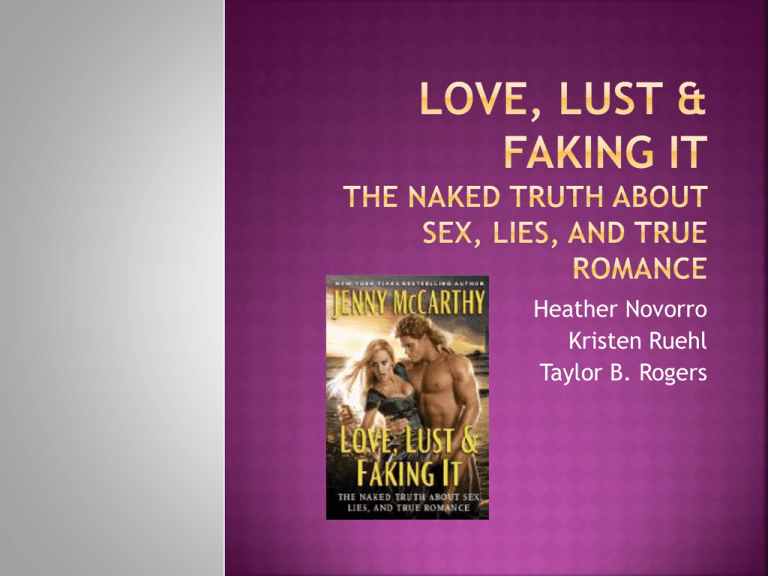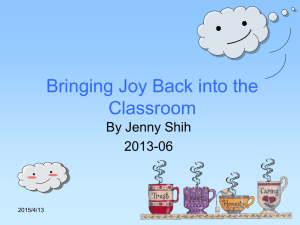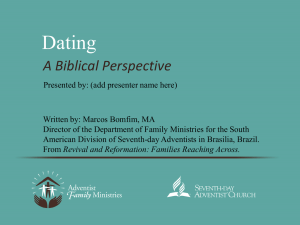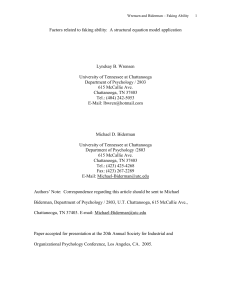
Heather Novorro
Kristen Ruehl
Taylor B. Rogers
Love,
Lust & Faking It
This book takes a look at different experiences of
love, relationships, sex and lies through the eyes
of Jenny McCarthy
The book is broken down into 3 parts: Love, Lust
& Faking It
In each part, Jenny recounts instances in her life
that deal with love, sexual experiences and fake
people and situations that she has come across
The stories and data that appear in this book all
come from episodes from Jenny McCarthy’s life
and are not necessarily credible. She admits this
throughout the book.
Young
o
o
love
Reconnecting with your first love years later
First loves shape how we are in future
relationships
Learning
o
o
Self confidence without a man
Standing up for yourself
Trouble
o
o
o
to love yourself
in relationships
Break ups
Abusive relationships
Couples counseling
Secret
o
o
o
o
Feeling comfortable with sexual desires
Threesomes
Fetishes
Prostitution in Las Vegas
Sexual
o
o
o
o
o
fantasies/sexual encounters
Advice
Songs to put you in the mood
General sex facts
Astrological signs-compatible sexual partners
Cheating
Booty calls
Fake
o
o
o
Fake Boobs
Botox
Lights off in the bedroom, so you seem to look
better than you actually do
Fake
o
o
o
bodies
personalities
Fake confidence
Fake sex
Fake friends
This book is about a number of things, we decided to focus on the main
theme: the connection between love and sex for men and women
Love and sex are inextricably linked and have been throughout time
Women and men have different views about love and sex: in some cases
they mean different things (Missildine, Feldstein, Punzalan & Parsons,
2005).
Gender roles complicate sexual desire, behavior and motivation
(Missildine et al., 2005)
Women tend to under-report their sexual desire, and men tend to
exaggerate it (Missildine et al., 2005)
Men are reported to be more sexually motivated, whereas women
are more romantically motivated. But both believe there is a
connection between feelings of love and feelings of lust (Missildine
et al., 2005)
“Thus there is an assumed theoretical link between the desire and
pursuit of short-term relationships and sexual motivation, and the
desire and pursuit or long-term, commitment oriented
relationships and romantic motivation, recognizing that sexual
compulsivity and romantic obsession represent extreme forms of
motivation.” (Missildine et al., 2005, p. 72)
Since everyone is different, each person has their own
style that affects the way they experience love and sex
Altruistic love: selfless. Make sacrifices for their partners. strive for
honest, patient, mature love (Hans, 2008, p.151)
Romantic love: characterized by passion and intense physical
attraction (Hans, 2008, p.151)
Game-playing love: value fun and self-indulgence over commitment
and emotional involvement. Enjoy having multiple partners (Hans,
2008, p.151)
Possessive love: passionate and insecure. Experience jealousy and
tend to be overprotective and possessive (Hans, 2008, p.151)
Pragmatic love: preoccupied with compatibility and may avoid
intimacy until relationship is perceived to have long-term stability
(Hans, 2008, p.151)
Friendship love: value shared experience and their intimate
relationships often come from long-term friendships (Hans, 2008,
p.151)
There is no background information in Love, Lust & Faking It
about love and sex, or men and women’s feelings about
them.
Dr. Helen Fisher – Science Behind Love
(Ph. D. works at Rutgers University)
Gavin de Becker (Oprah) – Abusive Relationships
(accredited Author and works with US Dept. of
Justice)
Elizabeth Halliday-Bluestone – Therapist
(Psychologist)
Byron Katie – Loving Yourself Before Anyone Else
Mark E. Petersen – Overcoming Masturbation
(book)
Patti Stanger – Threesomes (Millionaire
Matchmaker)
Suzanne Somers book “Breakthrough”
Prostitutes in Las Vegas
Interviews friends and family & polls on twitter
Interviewed
several friends about their
previous marriage and their divorce.
Interviewed
Dr. Elizabeth Halliday-Bluestone
on counseling. She states that many couples
come to counseling too late. Most just want
to know why their relationship didn’t work.
Jenny
tells the story of her parents divorce
and how she never thought it would happen
to them!
Data received from CDC (National Marriage & Divorce Rate Trends)
(Rate per 1,000
total population)
Data Received from CDC (National Marriage & Divorce Rate Trends
Year
Divorce &
Annulments
Population
20005
944,000
233,550,000
20015
940,000
236,650,000
20024
955,000
243,600,000
20033
927,000
245,200,000
20042
879,000
237,042,000
20051
847,000
234,114,000
20061
872,000
236,172,000
20071
856,000
238,759,000
20081
844,000
240,663,000
20091
840,000
242,497,000
1 Excludes data for California, Georgia, Hawaii, Indiana, Louisiana, and Minnesota.
2 Excludes data for California, Georgia, Hawaii, Indiana, and Louisiana.
3 Excludes data for California, Hawaii, Indiana, and Oklahoma.
4 Excludes data for California, Indiana, and Oklahoma.
5 Excludes data for California, Indiana, Louisiana, and Oklahoma.
…that impotence is grounds for divorce in 26 US
states? (impotence= inability to get an erection)
…that 85% of men who die of heart attacks during sex
are found to have been cheating on their wives?
…half of the men raised on farms have had a sexual
encounter with an animal?
…that kissing can keep the dentist away, because
saliva washed food from the teeth and lowers the
acid that causes decay?
…that the more sex you have, the more you will be
offered?
…that dolphins are the only known animals other than
humans that have sex for pleasure?
Source: (McCarthy, 2010, p. 156-157)
Evaluating
Jenny:
Dropped out of college
Famous playboy model, actress & comedian
Based on her own personal experience
Broke up with Jim Carey while writing this book
Is
This Book Helpful?
“Fun and funny guide to dating and
relationships”
No works cite page
Author Byron Katie:
Uses reference to author Gavin De Becker
Dr. Fisher from the Department of Anthropology
Uses her own therapist as a reference in the book
How
to make a better self help book:
Do not use one person’s perspective and
happenings
More supporting data and relatable chapters
Self-help books should be written by experts with
real research data
Not using an inner circle of friends and family
This self-help books covers a large number of topics. She
discusses love and sex through many aspects including her first
love, masturbation, fantasies, harassment, astrological signs, and
even songs to have on your booty call playlist. Through personal
stories and interviews with friends and some experts, she covers
love and lust in all forms and unlike what you may think, how
NOT to fake it.
The data in the book mainly comes from sources whom have no
real credentials and from non-representative samples of friends,
family and twitter followers. The data that we collected
discusses the divorce rates, which are the foundation for many of
the stories throughout the book. This data supported many of
stories Jenny told.
The biggest problems with the book would be the sources from
which she collected her information and the lack of statistical
data to support her stories and ideas. On the flip side, Jenny isn't
afraid to tell it like it is. Through this book, she encourages
women to believe in true love and to keep yourself in mind
before anyone else.
Use resources and national research
Help them find a date or stay in a relationship
Jenny makes it known this book is based on her
life, but for most readers, this book is a stretch
Data support her ideas
Example: “Pretty much all the baby boomers
were divorced” (McCarthy, 5)
1. Being preoccupied with compatibility and avoiding intimacy until relationship
is perceived to have long-term stability is an example of: (Answer is C)
A. Altruistic love
B. Possessive love
C. Pragmatic love
D. Romantic love
2. What was Jenny’s motivation for writing Love, Lust & Faking It? (Answer is D)
A. Starting a new relationship
B. Having a baby
C. She wrote it to help a friend
D. Her break up with Jim Carrey
3. What is the main idea of the book “Love, Lust & Faking It”? (Answer is B)
A. To enforce divorce
B. A fun guide on dating and relationships
C. To help manage stress
D. To help abused women
Cdc.gov/nchs/nvss/marriage_divorce_tables.htm
Clarity Digital Group. (2011, January). Retrieved April 14,2011 from
http://www.examiner.com/books-in-dallas/love-lust- andfaking-it-by-jenny-mccarthy-a-book-review-review
Hans, Jason. (2008). Do love styles predict lifetime number of sex
partners? American Journal of Sexuality Education, 3(2),
149-164. doi: 10.1080/15546120802104328
McCarthy, J. (2010). Love, lust & faking it. the naked truth about
sex, lies, and true romance. NY, NY: HarperCollins
Publishers.
Missildine, W., Feldstein, G., Punzalan, J., & Parsons, J.T. (2005).
S/he loves me, s/he loves me not. Questioning heterosexist
assumptions of gender differences for romantic and
sexually motivated behaviors. Journal of Sexual Addiction
& Compulsivity, 12,(65-74). doi:
10.1080/10720160590933662
West Lord. (2010, December). Retrieved April 14, 2011 from
http://www.westlord.com/jenny-mccarthy-website/












